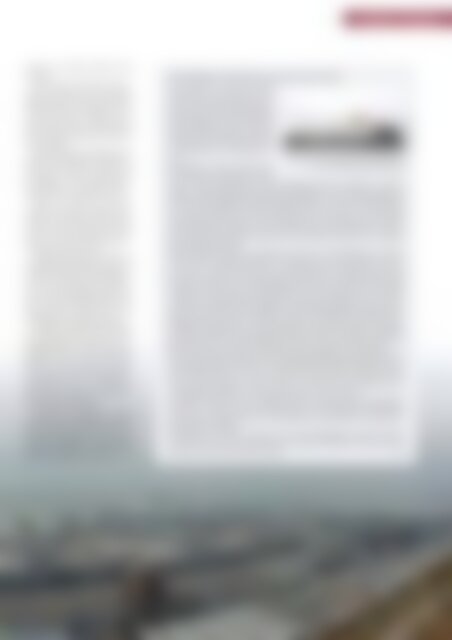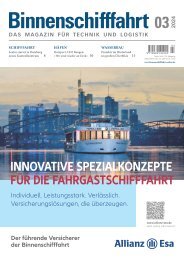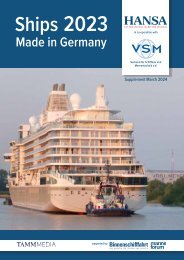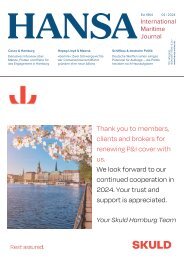HANSA 01-2019
Speditionen | Windantrieb | Tanker-Report | RAVE | Bilanz deutscher Häfen | Hyperloop | Fokus Bunker & Schmierstoffe | Shortsea | dship | Hansa Heavy Lift | Review HANSA-Forum
Speditionen | Windantrieb | Tanker-Report | RAVE | Bilanz deutscher Häfen | Hyperloop | Fokus Bunker & Schmierstoffe | Shortsea | dship | Hansa Heavy Lift | Review HANSA-Forum
Erfolgreiche ePaper selbst erstellen
Machen Sie aus Ihren PDF Publikationen ein blätterbares Flipbook mit unserer einzigartigen Google optimierten e-Paper Software.
Schifffahrt | Shipping<br />
increase in container traffic overall<br />
last year.<br />
»With the current Brexit uncertainty,<br />
we believe that our spread of<br />
dedicated short sea services can offer<br />
robust options for companies wanting<br />
to de-risk their supply chain in<br />
preparing for Brexit,« said Samskip<br />
UK & Ireland Regional Director,<br />
Richard Beales.<br />
Teesport belonging to PD Ports has<br />
begun receiving new Unifeeder direct<br />
routes to and from Antwerp and<br />
Dunkerque, as well as enhanced intermodal<br />
links to Scotland with addition<br />
of a second daily rail service.<br />
»Short sea services are the lifeblood<br />
of our ports and this partnership<br />
with Unifeeder offers more<br />
routes in and out of Europe and into<br />
the UK,« comments PD Ports general<br />
manager Kim Catterick.<br />
Teesport’s improved rail links to<br />
Scotland follow DFDS’s decision to<br />
terminate its Rosyth-Zeebrugge service<br />
last April. P&O Ferries responded<br />
by increasing freight capacity by<br />
25% on its Zeebrugge-Teesport sailings,<br />
which now interconnect with<br />
the improved Scottish rail service.<br />
Rising truck traffic between eastern<br />
Europe and the UK has been<br />
boosting P&O’s freight-only Zeebrugge-Teesport<br />
service, which also<br />
picked up some cargoes diverted<br />
from French channel ports because<br />
of industrial action and illegal migrant<br />
activity there in recent years,<br />
and could do so again in the event of<br />
post-Brexit border delays.<br />
»Customers want direct access<br />
and guaranteed schedules,« says PD<br />
Ports’ Catterick, which has led to »an<br />
increasing demand to move away<br />
from the congestion at some of the<br />
major European and UK ports.«ED<br />
The landbridge: Ireland looks to protect intra-EU trade<br />
The prospect of increased border<br />
checks after Brexit threatens to disrupt<br />
not only trade at Channel RoRo<br />
ports but also Irish traffic using the<br />
»UK landbridge« route to mainland<br />
Europe, which will need to cross not<br />
one but two EU-UK frontiers leads to<br />
a reconsideration of transport options.<br />
According to a latest report by the<br />
Irish Maritime Development Office<br />
»Celine«, the world’s largest shortsea RoRo ship,<br />
on service between Dublin and Europe<br />
3 mill. t of Irish traffic passes via the landbridge each year, roughly 2:1 exports/<br />
imports, representing 38% of Ireland’s total trade with EU. The value of goods was<br />
€ 21 bn in 2<strong>01</strong>6, of which 84% passed through Dublin – most of it using the shortest<br />
sea crossing to Holyhead in Wales and then by motorway to Dover – the remainder<br />
via Rosslare. Journey times to continental Europe are currently less than 20 hours<br />
via the landbridge, compared to up to 40/60 hours on direct RoRo/LoLo services.<br />
The savings are of particular importance to perishable cargoes such as Ireland’s<br />
dairy and seafood exports.<br />
Hence Ireland’s economy is »significantly reliant« on the landbridge and certain<br />
sectors will be »adversely affected by any deterioration in transit times or increases<br />
in costs,« concludes the report. It recommends the Irish government seek a<br />
post-Brexit solution »as close as possible to the status quo«, seeking extra EU funds<br />
to support continued use of the landbridge if necessary. However, the European<br />
Commission has proposed redrawing its North Sea-Mediterranean transport<br />
corridor to exclude the UK post-Brexit, instead introducing direct short sea connections<br />
between the ports of Dublin/Cork and Zeebrugge/Antwerp/Rotterdam.<br />
Shipping lines themselves are also laying plans to increase the number and capacity<br />
of direct sailings between Ireland and continental EU ports. Short sea and RoRo<br />
specialist CLdN of Luxembourg introduced its 235 m newbuilding »Celine« on<br />
direct freight service between Dublin and continental Europe in early 2<strong>01</strong>8.<br />
Irish Ferries still awaits delivery from Flensburger Schiffbau-Gesellschaft (FSG) of<br />
its new, larger RoPax »W.B. Yeats«, which is intended for Dublin-Holyhead service<br />
but will allowing other vessels to cascade down and increase capacity on direct<br />
routes to France. However, in the event of a »no-deal« Brexit it is thought the new<br />
vessel might be deployed on direct Ireland–France service instead.<br />
In addition, Irish Ferries has a freight-only sister company, Eucon, that operates<br />
direct LoLo container services linking Dublin, Cork and Belfast with Rotterdam<br />
and Antwerp – which will be alert to capturing unaccompanied box traffic defecting<br />
from the landbridge.<br />
BG Freight Line, X-Press Containers Lines (Doyle Shipping), Grimaldi and Brittany<br />
Ferries also operate Ireland-Continent sailings, while P&O, Stena and Seatruck<br />
Ferries run services across the Irish Sea.<br />
ED<br />
© Port of Dover<br />
© Port of Dublin<br />
<strong>HANSA</strong> International Maritime Journal – 156. Jahrgang – 2<strong>01</strong>9 – Nr. 1 43


















